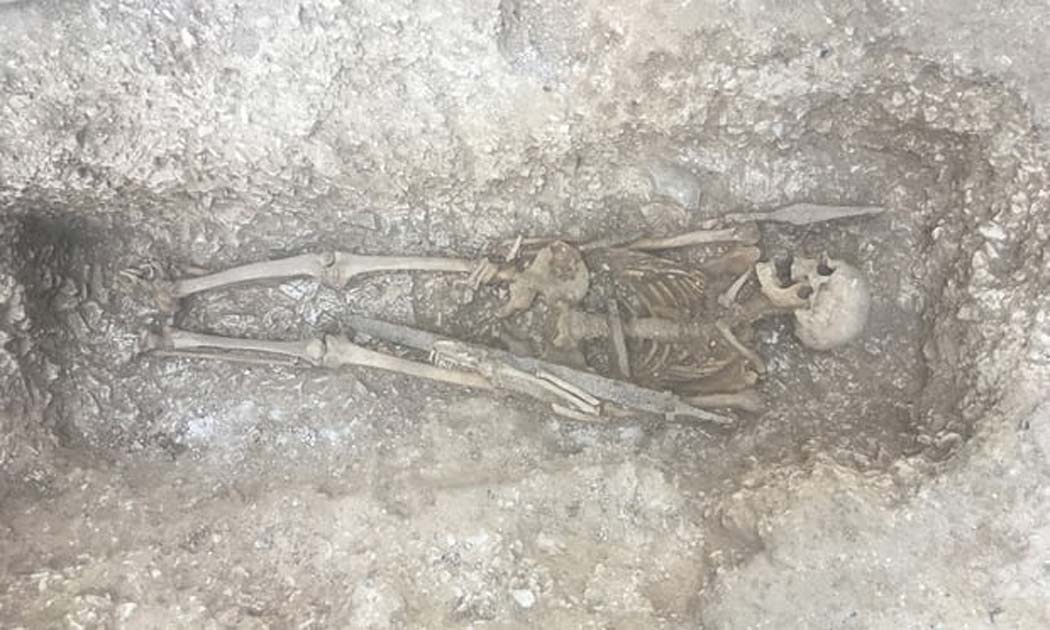Excavation of Saxon Warrior Touches Home with Veteran Volunteers
Operation Nightingale was an initiative that involved injured armed forces personnel, especially veterans who had returned from recent conflict zones such as Afghanistan, in archaeological fieldwork. They’ve just completed successful excavations at a Saxon cemetery on Salisbury plain. What they found on their last day of work struck a chord with many of the participants.
The Guardian reports that just before calling the project at Barrow Clump quits, a metal detector was used to give one last sweep of the site. Imagine their surprise when it gave out an unusually strong signal and a skeleton with well-preserved weapons was unearthed.

A skeleton with well-preserved weapons was unearthed at the Saxon cemetery on the last day of excavations. (Operation Nightingale)
The skeleton has been identified as a Saxon soldier who died in the 6th century AD. It was buried with a belt buckle, knife, tweezers, and had a spear at one side and a remarkably well-preserved pattern-welded sword in its arms. The sword still bears some of the wood and leather scabbard, which surprised Richard Osgood, leader at the site and senior archaeologist with the Defense Infrastructure Organization. It is a rather lucky find because the grave was found under a military trackway and the site has been damaged by plowing and badgers too. These kind of high status swords have rarely been found intact in better environments.
- More Than 80 Exceptionally Rare Anglo-Saxon Coffins Found in Previously Unknown Cemetery
- Anglo-Saxon Cemetery Full of Grave Goods Discovered Near Prehistoric Henge Monuments
- New Study Analyzes a Mesolithic Cemetery Full of Children and an Odd Standing Burial
Osgood said that he felt some conflicting emotions when he found out about the discovery.
“It was a classic last day of the dig find – there was such a buzz across the site, the soldiers definitely had a sense of kinship. I have to admit I also thought ‘there goes my budget’ – there was quite a tricky conversation afterwards with the MoD because of the sudden increase in conservation costs.”

Saxon spear from the burial. (Operation Nightingale)
There was also a new buzz and a moving moment when the word spread amongst the veterans, according to The Guardian, “The soldiers were very moved by the discovery of a man they felt would have shared some of their experiences.”
Several burials of men and women have been found during the three weeks of excavations at the site. The men were buried around the edge of the Saxon cemetery and women and children were placed in the center. Weapons and jewelry were popular grave goods. A few of the other notable finds included a man which was buried with a sword, a girl with a large amber bead, and a little boy curled up without grave goods. Osgood believes that the deceased once lived in a settlement below, and told The Guardian “It’s that Saxon thing of looking up the hill and knowing your ancestors are up there on a site that was already ancient and special.”

A child buried with a Chatelaine or purse in the Saxon cemetery. (Operation Nightingale)
Barrow Clump itself is a site that has been occupied since the Neolithic period. A Bronze Age burial mound and the Anglo-Saxon cemetery were later additions. Unfortunately, much of the site has been damaged by the previously mentioned factors. Recently badgers have been digging up human bones, which is the reason excavations have been permitted.
Dig partner Wessex Archaeology has taken the artifacts to continue analysis and conservation, but the objects will eventually be bequeathed on the Wiltshire Museum in Devizes.
- Second Anglo-Saxon cemetery with fascinating grave goods unearthed near Stonehenge
- Student’s Lucky Find Worth £145,000 Is Rewriting Anglo-Saxon History
- What English Site is So Favored that Human Activity Spans Across 12,000 Years There?

A skull excavated at Barrow Clump in Salisbury Plain. (Crown Copyright 2018)
The Ministry of Defence, the controlling body for Operation Nightingale, sees a link between the skills veterans have acquired with those needed for archaeological fieldwork:
“There is a close correlation between the skills required by the modern soldier and those of the professional archaeologist. These skills include surveying, geophysics (for ordnance recovery or revealing cultural heritage sites), scrutiny of the ground (for improvised explosive devices or artefacts), site and team management, mapping, navigation and the physical ability to cope with hard manual work in often inclement weather conditions.”

Last November, remains outside the barrow were found including a man with an iron spear and a woman with jewelry. (Twitter)
Apparently, the project has been quite successful and The Guardian reports “several of the veterans have retrained as professional archaeologists.”
Top Image: This 6th-century Saxon warrior with spear and sword, was found underneath a military trackway, frequently crossed by tanks and huge military vehicles. Source: Crown Copyright 2018

















